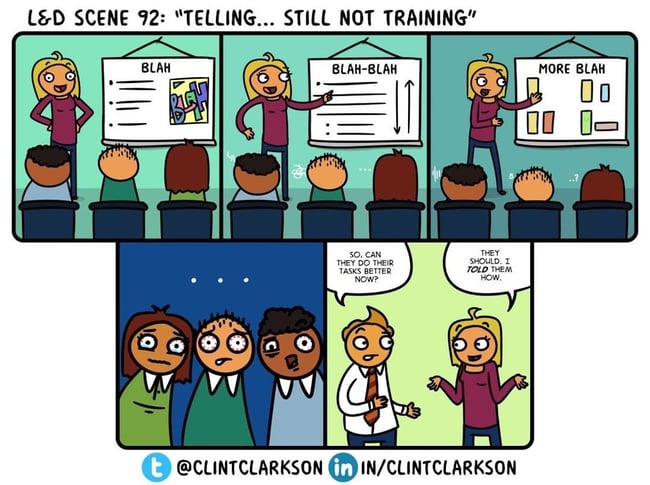6 Reasons Your eLearning Courses Fail (and How to Fix Them)
You put in your best resources and efforts to develop perfect eLearning courses. Yet, they end up failing! Find out why eLearning initiatives fail.

“Ugh, this eLearning course is so boring!” “How do I move on to the next slide?!?”
How often have you come across such comments from your employees? You take months developing that perfect eLearning course or working with an eLearning vendor to deliver that perfect eLearning course to train your employees, but all in vain.
6 Reasons Your eLearning Courses Might be Failing
- Poor planning and project management
- Courses unaligned with learner needs
- Using course completion status to measure success
- Courses being passive
- Lack of flexibility within the course
- Lack of adequate quality checks
eLearning is indeed becoming the first choice of more and more organizations for employee training since it has proved its efficiency in gaining learners’ attention, keeping them engaged, and in aiding better retention and recall. Yet you come across eLearning initiatives that fail. Why is this so?
6 Major Reasons eLearning Courses Fail
1. Poor Planning and Project Management

Image Source: https://www.linkedin.com/
THE PROBLEM: “Failing to plan is planning to fail.” This phrase by Alan Lakein is indeed apt in the case of eLearning project management. Often, the primary reason for the failure of an eLearning initiative is lack of proper planning and project management. While sometimes it might be the lack of communication between the vendor and the client, at times it might be the lack of well-defined targets or deadlines.
THE FIX: To ensure your eLearning initiative succeeds, there are a few factors you need to keep in mind, especially if you outsource eLearning design and development:
- Ensure there is a dedicated Project Manager for each project, and he/she acts as the single point of contact to deal with the vendor.
- Ensure the project management process is clearly defined and iterative i.e., continually checking with the vendor and ensuring feedback is provided early on, rather than waiting till the end.
- Ensure you communicate clearly with your vendor as to what your expectations are to avoid complications and delays.
- Ensure the vendor has a dedicated team in place for the project.
- Ensure that answers to all queries from the vendor are provided right in the beginning.
- Ensure a realistic deadline is established.
2. Course Content Unaligned with Learner Needs
THE PROBLEM: Trainers often feel every bit of information is important and needs to be included in the course. But this might not be the case. You first need to identify what the performance gaps of your target audience are. Once this is identified, the content within the eLearning course should be aligned to address these performance gaps.
So, you develop just the right course for your learners – perfectly aligned with their needs. But how do you let them know this? According to adult learning principles, human beings are goal-oriented – your employees will only learn if they are sure whatever they have learned will have an impact on their work. The primary way you convey what your employees will attain once a course is taken up is through the learning objectives.
A learning objective is a statement provided at the beginning of a course explaining learners what they will be able to do once they complete the course. If a learning objective is poorly written, it will not just demotivate and confuse learners but also make it nearly impossible to measure the learning outcome.
For example, take a look at this learning objective.
“You will know about all the important data privacy policies”
Now, what’s wrong with this learning objective is that, it’s unclear what exactly the learner will achieve once they complete the course and measuring the knowledge is near to impossible.
THE FIX: You should always ensure learning objectives are performance-based. For this, you need to use verbs from the Bloom’s taxonomy – which is used to specify the learning objectives for programs at various levels of the cognitive domain. Take a look at the right way to frame this objective below:
“You will be able to list down the important data privacy policies”
This objective is performance-based and measurable. Once a learner reads this objective, they will understand what they are going to achieve, thus getting motivated to take up the course.
|
Thumb rule: Avoid immeasurable words such as understand, know, think critically, and appreciate, and use measurable terms such as list, explain, measure, and calculate. |
3. Using Course Completion Status to Measure Success
THE PROBLEM: We often notice that course completions are used to measure success. But do you really think just because your learners have completed taking up a course, you have succeeded in training them or they have succeeded in learning everything? Not really. Maybe they just skimmed through the course. Or maybe they did go through the course taking time and yet did not understand.
THE FIX: In eLearning, you can track a lot more than just the completion of a course. The first thing you need to ensure is the inclusion of a summative assessment within your course. Summative assessments are provided at the end of a course to evaluate if learners gained the knowledge necessary to achieve the learning outcomes.
And then the integration of a Learning Management System. A Learning Management System is a software application that allows administrating, deploying, and tracking of all training activities. An LMS allows you to track various activities such as the following.
Performance in summative assessments: The scores of the summative assessment will help you understand if learners acquired the intended knowledge from the course. Using an LMS quiz engine, you can also track the number of re-tries each learner had taken and the amount of time spent on each question.
Time spent on each course: If your learners just skimmed through, it might indicate they are not motivated enough to take the course, they believe the course does not have anything of value, or they already know the content being covered in the course.
Time spent on each slide: If a majority of your learners are spending too much time on a particular slide or for a particular module, it might imply that either the subject is something they are not familiar with or it’s difficult understand.
Other than these, there are many other activities an LMS can track. Tracking these activities will help you identify where the course went wrong and help you identify where you can improve it to deploy an effective training in the future.
4. Courses Being Passive

Image Source: https://www.linkedin.com/
THE PROBLEM: “Tell me and I forget. Teach me and I remember. Involve me and I learn,” said Benjamin Franklin. This is valid, even in the case of eLearning. Maybe you include the right content – content perfectly aligned to the needs of the learners within your eLearning course. But as long as you do not involve them and do not let them participate or engage with the course, it will cease to motivate learners.
THE FIX: eLearning provides myriad ways by which you can involve your learners within the course.
Include interactivities: Instead of letting your learners go ‘click, click, click’ include other ways to engage them physically with the course. For example, instead of merely reading text, you can include a click-and-reveal interactivity by which your learners will have to click a particular element to view information.
Add a ‘drag and drop’ interactivity instead of merely posing a multiple-choice assessment on product parts and its usage. You can also include many other interactivities such as rollovers and click-on-tabs to ensure your learners stay engaged.
Include simulations: Instead of merely educating learners on the steps to perform certain actions within a software or showing a video of how to do it, allow your learners to get involved in the learning process by providing simulations. eLearning simulations provide learners a safe platform to practice and try out various actions within a controlled environment, which is the replica of the actual environment the learner will be working in. Thus, your learners can practice without the fear of failure and gain efficiency in all the skills before having to put in the skills in their workplace.
Include problem-based scenarios: Instead of asking your learners to read a case study on a problem and how it was solved, incorporate problem-based scenarios to let them work through them and come up with solutions. For example, if you want to train your learners on policies against workplace harassment, use problem-based scenarios on the various situations they might come across at their workplace and how they would deal with them or solve them.
Include rhetorical questions: Involving your learner does not have to be confined to mere physical involvement. It can also mean involving with the course mentally. This can be done by posing rhetorical question such as icebreakers before the start of the course/each topic. While the response might not be visible, it requires learners to think deeply, thus engaging them.
For example, if you are planning to train your employees on safety measures, you can pose the question, “What is the protective equipment you need to wear before you rush into a hazardous zone?” This will make them think before they move on to the next slide.
5. Lack of Flexibility Within eLearning Courses
THE PROBLEM: Yes, eLearning is known for its flexible nature. No more being bound by the four walls of a classroom. Learners can take up the course anywhere, anytime, and according to their own pace. Even if the learner has to stop taking the course at a particular time, they needn’t worry. They can retake the course from exactly where they stopped.
Yet we notice that there is a lack of flexibility within the course itself – learners unable to navigate freely, the navigation being too confusing, only a single presentation pattern being used to disseminate information throughout, and more.
THE FIX: No matter how interesting a course is, or no matter how aligned the course content is with the needs of your learners, if the course is not flexible, there’s absolutely no point. A few ways you can ensure your course is flexible is:
Provide free navigation: Ensure navigation within the course is not restricted and learners can navigate through the entire course as per their needs.
Ensure navigation is not confusing: Standardize the navigation buttons throughout the course. Placing them in various positions in different slides will only end up confusing learners. Also ensure clear instructions are provided to navigate.
Ensure various presentation patterns are included: Instead of merely disseminating your course content through text or slides with text and images, offer other formats such as videos, infographics, and simulations to break monotony.
Provide additional resources: Nice-to-know content, the valuable yet not so important content, related topics that might interest learners – all these can be delivered as additional resources. They can be provided in various formats such as infographics, checklists, and bite-sized videos.
6. Lack of Adequate Quality Checks
THE PROBLEM: Quality is often compromised. Quality checks might indeed be time consuming, but it’s important to have them in place to ensure the effectiveness of your eLearning courses once they are launched. A single error – a small typo, mismatch in the audio sync – in your eLearning may cost you the overall effectiveness of the course, leading to the failure of your initiative.
THE FIX: To ensure a course is of flawless quality, according to Michael Allen, the author of ‘Michael Allen’s Guide To eLearning’, you need to ensure quality analysis takes place within every iteration of the development process, rather than just at the end. Also, you need to ensure that sufficient time is spent on quality checks. Here are a few elements you need to double check during this process:
- Are the grammar and spellings appropriate?
- Does every image in the course make sense?
- Are the navigation and other interactivities in the course clear?
- Are the fonts, colors, navigation icons consistent throughout the course?
- Have the brand guidelines been followed consistently?
- Is the course culturally appropriate?
- Is the scoring in assessments accurate?
- Is the audio synced with the appropriate slides?
|
Besides all these, before delivering the course to your target audience, pick a few learners to pilot the course. A fresh eye could be extremely helpful in getting hold of errors and also knowing if the course indeed met the learning objectives. |
The 6 reasons discussed here are the major reasons your eLearning courses might be failing. As a training manager, it’s your responsibility to ensure the course being delivered is effective and will meet the needs of your learners. Would you like to get a few more hacks on delivering the best courses to your employees? Download our free eBook ‘32 eHacks to Jumpstart Your eLearning’ to guide you toward successful eLearning implementation!





